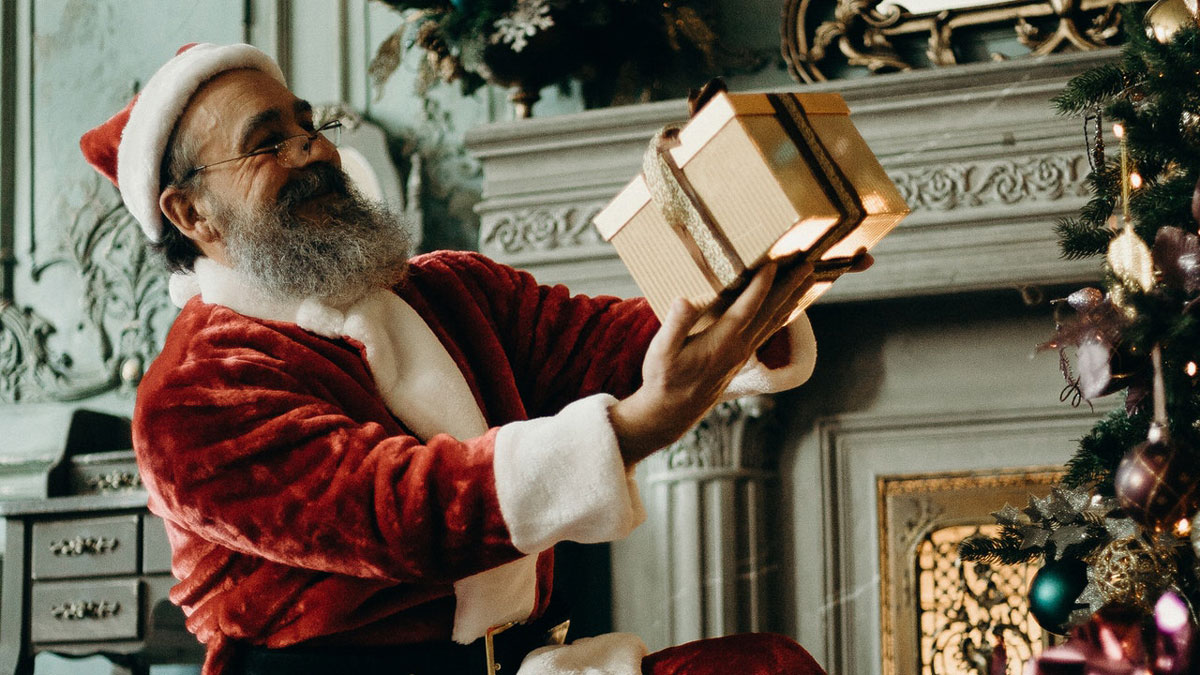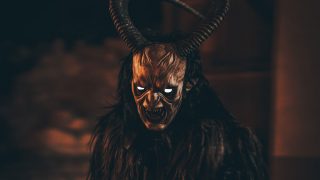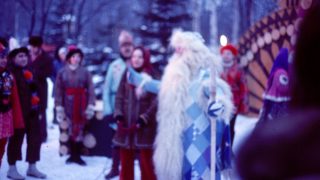Santa Claus has established in our imagination as a jolly man in round glasses and a red suit.
But centuries ago, people had varying opinions regarding his look and personality.
Many of us are familiar with the story of Saint Nicholas, a bishop who served as an inspiration for modern Santa. But he wasn’t the first to give out gifts to children.
Long before Christianity had established in Europe and Saint Nicholas was born, Europeans praised pagan Gods who gifted them good weather and protection from evil spirits.
Even after Christianity was accepted in the region, people didn’t give up their traditions of celebrating winter festivals, tying them with new customs.
There were even times when Christmas was viewed as controversial or outlawed. But Santa has withstood all prohibitions and attempts to replace him with someone else.
Thankfully, in modern America, no one is forced to give up Christmas traditions. The image of a cheerful, kind man distributing gifts to children has been ingrained in our culture and is very unlikely to change any time soon.
Table of Contents [show]
Saint Nicholas, the Original Santa
Saint Nicholas is the very origin of modern American Santa Claus. But unlike the Santa we’re all familiar with, Saint Nicholas wasn’t a plump, happy man with a white beard. He didn’t reside on the North Pole or ride reindeer either.
Nicholas was born in the fourth century in Myra, which is modern Turkey. His parents passed away when Nicholas was young, leaving him a large inheritance.
However, instead of living in prosperity, Nicholas gave away the money to the poor and became a bishop.
Numerous legends tell of the deed that earned Nicholas the Saint title. One is especially notable, being the origin of hanging stockings on a chimney tradition.
According to the story, Nicholas knew a poor man who couldn’t afford to marry his three daughters.
As Nicholas was wealthy, he sneaked on the man’s roof and dropped gold in a stocking down the chimney. The man then married his older daughter.
Nicholas repeated the action two more times so that the man could marry the remaining daughters.
Although Nicholas didn’t want any attention, the entire Myra soon found out about his kindness. To our day, children hang stockings on a fireplace, waiting for good old Saint Nicholas to bring them treats.
The word about Saint Nicholas continued to spread for long after his death.
He was the symbol of Christmas until the early 16th century in Europe but has been banned for nearly three hundred years by the Protestants. And still, Saint Nicholas’ heritage remained.
Father Christmas
The British have a different from our perception of Santa Claus. Today, Father Christmas and Santa Claus figures are often considered interchangeable, but it isn’t historically correct.
Father Christmas existed for long before Saint Nicholas came into the picture. Pagans praised Father Christmas as the symbol of coming spring during winter solstice festivals.
Father Christmas’ appearance was nothing like Santa’s. He was typically portrayed wearing a long green robe, replicating the color of evergreen plants representing everlasting life. A wreath of holly or mistletoe would often adorn his head.
Father Christmas wasn’t associated with gifts until Britain fell under Saxon rule in the fifth century.
Father Christmas then borrowed characteristics of Saxon King Winter. He would come to people’s homes asking for something to eat or drink and get a mild winter in return. The legend may be true, considering the British weather.
The image of Father Christmas as the gift-giver was later strengthened by the Vikings. They brought their own tradition of celebrating the Yule festival.
Vikings believed Odin was roaming the night sky with other Norse Gods, celebrating his Great Hunt during the last weeks of December.
Odin was riding a sleigh pulled by his horse Sleipnir, had a white beard, and gave gifts to children. Sounds familiar?
Father Christmas has soon adopted Odin’s look, so British and Scandinavian Christmas traditions became closely tangled.
Germanic Paganism & Christianization
Germanic Christmas folklore is full of wonders. While most nations portrayed the Christmas spirit as a kind man giving out gifts, the Germans had some truly strange and, sometimes, horrifying associations.
Frankly, German pagans had different perceptions of the Christmas spirit depending on the region. Some believed in Frau Holda, who was a Goddess of winter.
Others preferred Frau Gauda, a dog Goddess who was roaming the streets at night with three ghost hounds. They would kill the owners or bring bad luck to any unlocked home on their way.
A more popular German Christmas symbol is Krampus, Santa’s evil twist. Krampus was originally the son of the pagan God of the underworld and had nothing to do with Christmas.
He was believed to hunt children who behaved badly and punish them with birch rods.
With the establishment of Christianity in the early fourth century, the word of Saint Nicholas reached Germany, too. Smart Germans came up with a brilliant idea – Krampus would now assist Saint Nicholas.
While the latter was giving treats to well-behaving children, Krampus would punish the rest.
After the Protestant Reformation, Saint Nicholas was prohibited in Germany and replaced with Christkind, a blonde angel-child.
But even despite three centuries of exile, the memory of Saint Nicholas managed to remain and later was revived stronger than ever.
Sinterklaas Arrives in New York
America was the latest to adopt Saint Nicholas as a Christmas gift-giver. But they were to first to call him Santa Claus.
The Dutch called Saint Nicolas Sinterklaas. His legend came to America in the late 18th century when Dutch sailors started colonizing the continent.
So, The New York newspaper mentions Dutch families honoring Saint Nicholas on his death anniversary in 1773 and 1774.
The modern depiction of Santa Claus was developed exactly at this time. For instance, a commissioned artist Alexander Anderson drew Santa for Saint Nicholas’ death anniversary dinner held by The New York Historical Society in 1810.
In his drawing, Santa has a white beard and puts gifts in stockings hanging on a fireplace.
Washington Irving has also mentioned Santa, describing him as a cheerful man in a blue har, red coat, and yellow stockings.
Image of Modern Santa in Culture
Our perception of Santa’s look was finalized and popularized by two people. Although many believe his appearance is the work of Coca-Cola, the real fathers of Santa Claus image are Dr. Clement Clarke Moore and Thomas Nast.
Dr. Clement Clarke Moore wrote the poem “T’was the Night Before Christmas” in 1821 for his daughters.
In this piece of literature, Santa is described as a plump and cheerful man with a large belly and long beard. He’s smoking a pipe and carries a sack of toys.
About 60 years later, Thomas Nast has created a portrait of Santa inspired by Moore’s poem that was published in Harper’s Weekly. In fact, Nast has drawn Santa multiple times in various outfits, but always jolly and chubby.
Shopping Mall Santa
We’re all used to shopping mall Santas, but not many know that they aren’t a modern invention. Historical evidence suggests mall Santas have existed since the early 19th century.
The jolly image of Santa Claus has been used in Christmas advertising since the 1820s. By the 1840s, American newspapers started devoting entire sections to Christmas shopping.
And finally, in 1841, a store in Philadelphia displayed a full-sized, realistic Santa in a red suit, capturing the attention of thousands of children of the state.
The idea of real people dressing up as Santas was first used solely for charity purposes. So, in the 1890s, The Salvation Army began soliciting change for the poor in red Santa suits. This practice exists to our day.
Santa Claus in Other Cultures
Over time, the borders between Christmas traditions of different countries began to fade. Today, determining the origins of Santa Claus in a particular country is a tough task.
Most regions have accepted the plump and cheerful Santa in a red suit, yet some have preserved their unique perception of the Christmas spirit.
For instance, the Russian Santa is called Ded Moroz, which translates as Grandfather Frost. He’s a wizard dressed in an embellished long kaftan, carrying gifts to children along with his granddaughter Snegurochka, or Snow Maiden.
Swedes view Santa as a dwarf-being named Tomte or Jultomten. He’s believed to protect homes from bad luck. Norway’s Julenissen are not much different from Jultomten, being pixies who serve as spirit guardians over farms.
Some countries consider the Christmas spirit to be a woman. For instance, Italians believe in witch La Befana, who has originated from the Bible, while Northern Swedes praise Saint Lucia.
The Santa Claus Problem
Saint Nicholas’ journey to becoming widely accepted Santa Claus was a bumpy ride.
Celebration of Christmas and Santa Claus were prohibited numerous times, starting with the 16th century Protestant Reformation.
Protestants didn’t ban Christmas completely but rather have changed the traditions. Saint Nicholas was considered a controversial figure and replaced with Christkind in Germany.
A major part of other Northern and Central European countries has followed Germany’s example. Thankfully, Santa’s image in Europe was revived in the early 19th century.
The Soviets were stricter than Protestants and have prohibited everything related to Christmas following the doctrine of state atheism.
People continued celebrating their religious holidays behind closed curtains, and with the fall of the Soviet Union, Christmas returned.

























